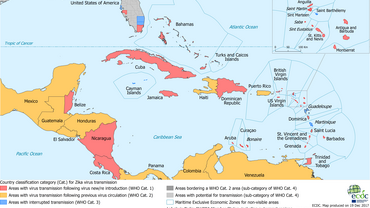Zika transmissionArchived
Zika transmission maps have stopped being updated in January 2018, as a result as a result of the significant slow-down of the epidemic. ECDC is working with the World Health Organization and the United States CDC to assess the current risk of Zika virus transmission in countries and territories globally
Information on the level of Zika transmission is useful for public health professionals to evaluate the level of risk for people who may be planning to travel to or are recently returning from areas with possible local transmission.
A revised scheme has been developed by WHO, in collaboration with the US CDC and ECDC, to categorise the epidemiological profile of vector-borne Zika virus transmission in countries and territories. The classification can be applied at the national level as well as subnational level when the necessary information is available. ECDC has adapted the classification scheme to reflect the risk to travellers more accurately. It replaces the previous ECDC classification and the WHO interim guidance on Zika virus surveillance published in April 2016.
For a summary description of the revised scheme and a description of the ECDC adaptation see the updated ECDC rapid risk assessment. For the full description of the WHO categories, see the Zika virus country classification scheme, Interim guidance, March 2017.
Maps
Zika transmission on December 2017
This information aims at aiding diagnosis for returning travellers, especially pregnant women with travel history during pregnancy, returning from countries and territories that have recently experienced or are currently experiencing local Zika virus transmission.
Map and table
Map
Zika transmission in past nine months
Countries and territories worldwide with reported confirmed autochthonous vector-borne transmission of Zika virus infection in the past nine months. The information is provided to aid diagnosis for returning travellers, especially pregnant women






